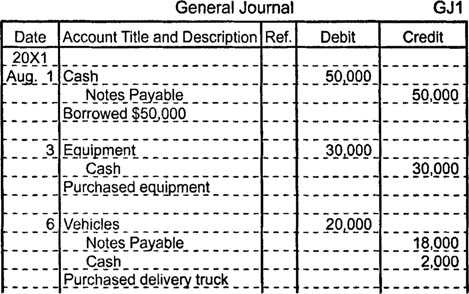Journal Entries
Tracking business activity with T accounts would be cumbersome
because most businesses have a large number of transactions each day.
These transactions are initially recorded on
source documents, such as invoices or checks. The
first step in the accounting process is to analyze each transaction and
identify what effect it has on the accounts. After making this
determination, an accountant enters the transactions in chronological
order into a journal, a process called
journalizing the transactions. Although many companies use specialized journals for certain transactions, all businesses use a
general journal. In this book, the terms
general journal and
journal are used interchangeably.
The journal's page number appears near the upper right corner. In
the example below, GJ1 stands for page 1 of the general journal. Many
general journals have five columns: Date, Account Title and Description,
Posting Reference, Debit, and Credit.
To record a
journal entry, begin by entering the date of the
transaction in the journal's date column. For convenience, include the
year and month only at the top of each page and next to each month's
first entry. In the next column, list each account affected by the
transaction on a separate line, and enter a short description of the
transaction immediately below the list of accounts. The accounts being
debited always appear above the accounts being credited, which are
indented slightly. The posting reference column remains blank until the
journal entry is transferred to the accounts, a process called
posting, at which time the account's number is
placed in this column. Finally, enter the debit or credit amount for
each account in the appropriate columns on the right side of the
journal. Generally, one blank line separates each transaction.

Tidak ada komentar:
Posting Komentar